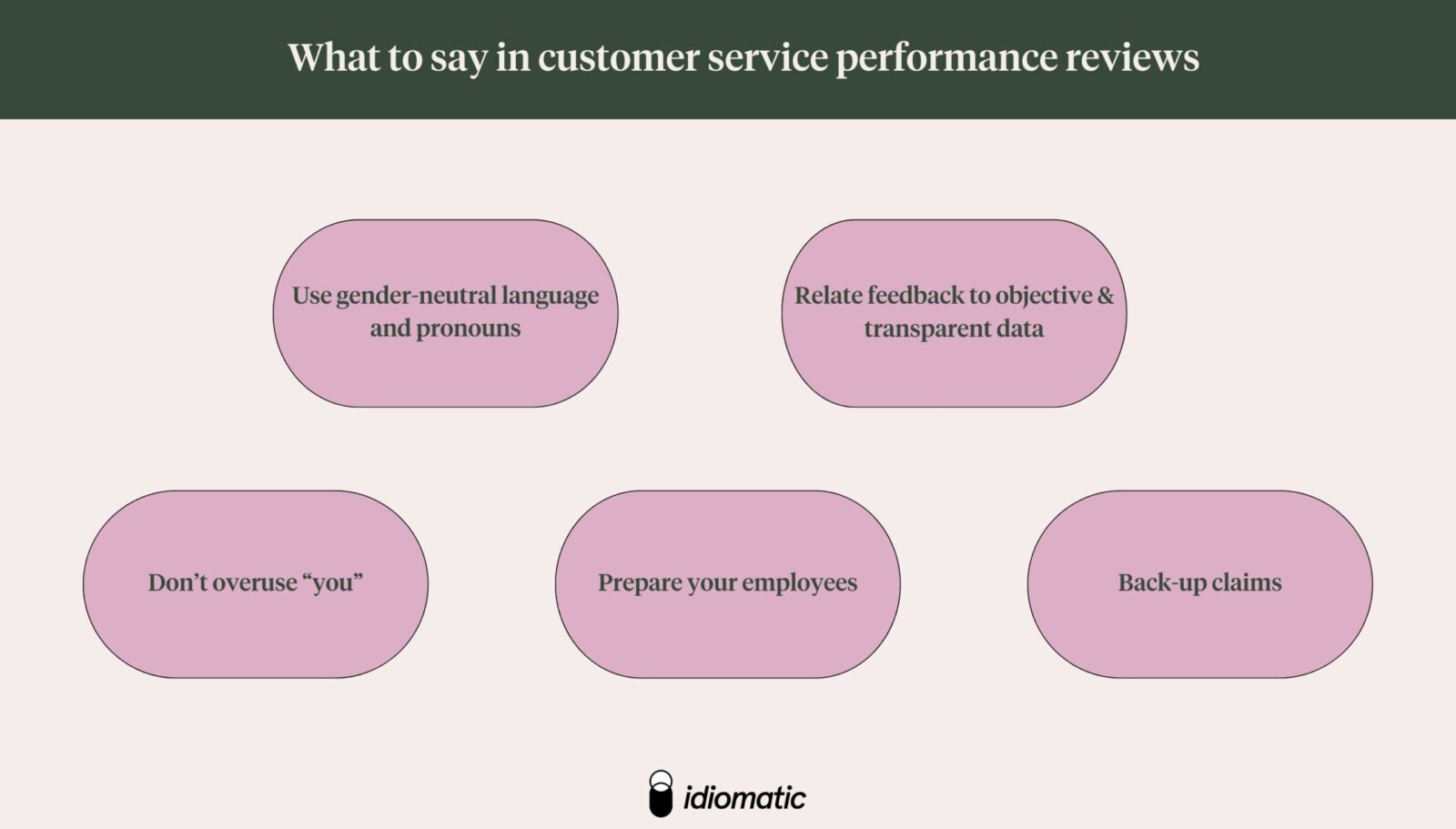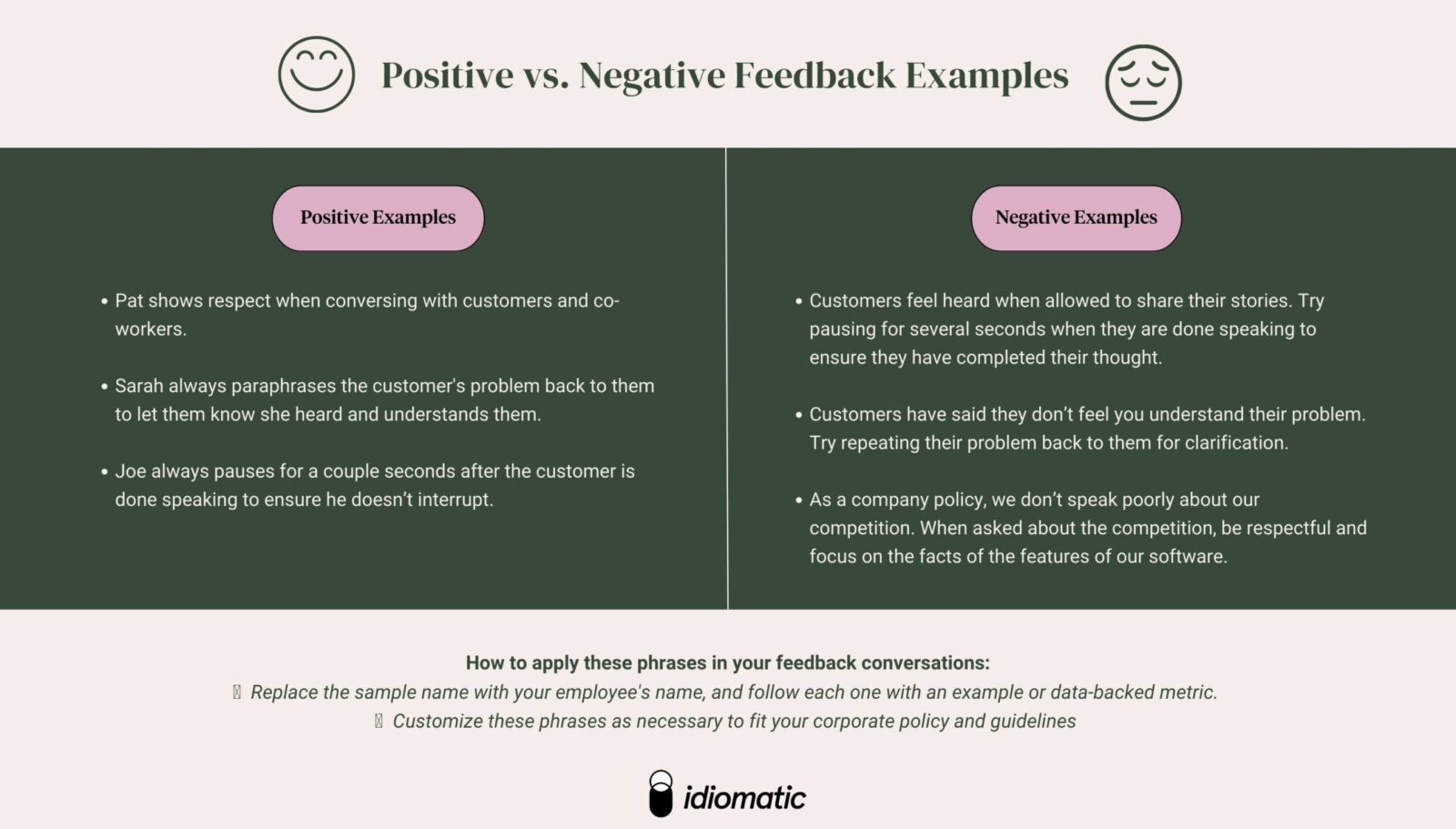Your words matter. That’s why the ones you choose are critical when doing performance reviews of your customer service team. You need them to be objective, transparent, and actionable, without bias-creep or disengagement.
It can be a tricky balance to master. But when you’re prepared with a few key phrases to use, you can make customer service performance reviews helpful for employee growth and your organization’s betterment.
In this article, we’ll give you tips on avoiding bias creep and disengagement in performance reviews and share examples of good (and bad) customer service phrases for performance reviews.
Contents
- What are customer service performance reviews?
- What should I write (or say) in customer service performance reviews?
- 24 Examples of customer service performance review phrases
- How to use these phrases in a performance review to provide specific and actionable feedback?
- How to avoid bias-creep and disengagement
- Where to get the best customer service metrics for performance reviews
What are customer service performance reviews?
Customer service performance reviews are discussions held with employees on customer services teams, usually held annually, semi-annually, or monthly. They measure employee performance, provide constructive feedback, and set performance goals and expectations. They can also be done at the end of probationary periods.
These conversations usually include a discussion about:
- Job performance (using measurable KPIs when possible)
- Job satisfaction and fit
- Goal setting for the next period
- Planning for their future at the company (promotions or succession planning)
Data-based performance reviews provide a deeper understanding of the issues and successes of the employee through examples (such as customer support transcripts) and metrics (like time to resolution or number of customers helped).
What should I write (or say) in customer service performance reviews?
In addition to specific phrases you should use to provide both negative and positive feedback (which we’ll share in the next section), there are a few higher-level tips for how to frame your language in customer service performance reviews:
- Use gender-neutral language and pronouns: Always address your employee using their preferred pronouns. If you don’t know, ask during the interview. Also, ensure you’re not an “ist” (racist, ableist, ageist, classist).
- Don’t overuse “you”: Using the word “you” too often can come across as accusatory if used in the wrong tone.
- Prepare your employees: Don’t spring a performance review on your call center employees randomly. Make it a regular occurrence that they know to expect. This gives them (and you) time to prepare questions or discussion points. Being caught off guard can be off-putting, especially for customer service employees who may not be performing satisfactorily.
- Back-up claims: If you tell an employee their customer service performance is lower than expected, reiterate what was expected and share the scores that contributed to this claim. This may include reviewing insights from your customer satisfaction software with them (such as customer chat transcripts or responses from customer satisfaction surveys).
- Relate all feedback to objective and transparent data: To avoid bias or favoritism, ensure all team members know their personal and company objectives and success criteria. This gives people a clear goal to measure their performance against and keeps all team members working towards the same goal without biased performance reviews.

24 Examples of customer service performance review phrases
Here are examples of phrases you can use in performance reviews. We’ve organized them by category of feedback—positive or negative. For each, we’ve given examples of how to communicate that feedback so it comes across as empathetic, helpful, and actionable, and not as a personal attack.
(Replace the sample name with your employee’s name, and follow each one with an explanation or elaboration when needed. Customize these phrases as necessary to fit your corporate policy and guidelines)
Communication
Good communication is a crucial skill for good customer service agents. Employees who can effectively communicate and have good listening skills can better de-escalate angry customers and minimize any misinterpretation, leading to better customer support outcomes for the customer.
Positive Feedback
- Pat shows respect when conversing with customers and co-workers.
- Sarah always paraphrases the customer’s problem back to them to let them know she heard and understands them.
- Joe always pauses for a couple seconds after the customer is done speaking to ensure he doesn’t interrupt.
Negative Feedback
- Customers feel heard when allowed to share their stories. Try pausing for several seconds when they are done speaking to ensure they have completed their thought.
- Customers have said they don’t feel you understand their problem. Try repeating their problem back to them for clarification.
- As a company policy, we don’t speak poorly about our competition. When asked about the competition, be respectful and focus on the facts of the features of our software.
Problem-solving
The ability to problem solve helps your customer support team members solve customer queries faster and often to greater satisfaction. When customer service reps can solve problems quickly, they can minimize customer wait times and the associated frustration.
Positive Feedback
- Jen’s ability to find creative solutions to customer problems is shown in customer feedback scores.
- Max has shown a strong ability to stay up-to-date on the particulars of our software releases to better respond to customer queries.
- Sarah can often find an equitable solution for customers quickly.
Negative Feedback
- Check your weekly emails for news and announcements regarding service updates and the company’s products. This will help you respond to customer queries quicker than asking a colleague.
- To help expedite resolutions for our customers, review our employee manual about allowable discounts and concessions you can offer disgruntled customers without manager approval.
- You’re seeking co-workers’ assistance too often for “common” questions. Let’s review which issues should be escalated and where we can improve your knowledge or confidence to answer for customers independently.
Empathy
Showing empathy is also essential in customer service roles. Honesty and showing empathy can be accomplished through the agent’s word choice and tone.
Positive Feedback
- Sam shows good empathy towards customers.
- Saeed works well with difficult customers, giving them feedback and information they need with a kind, empathetic attitude.
- Bella is excellent at focusing on the customer’s needs with minimal sidetracking.
Negative Feedback
- Customer feedback shows customers feel you are disengaged and speak in unenthusiastic tones during conversations. Let’s find ways to increase enthusiasm during calls.
- Customers say you’re too chatty during calls. Let’s review some transcripts to see why this is happening so we can refocus the conversation.
- Sarcasm isn’t appropriate in customer service settings as it offends and alienates customers. Let’s practice some ways to avoid sarcasm.
Conflict resolution
Inevitably, conflicts will arise and call center employees should be able to approach them calmly and without unnecessary emotion.
Positive Feedback
- Glen always follows up with all customers, especially difficult ones, promptly.
- Tina promptly seeks approval from management regarding difficult customers to prevent escalations.
- Maxine deals with her role’s emotional and mental demands well and doesn’t lose patience with difficult customer demands.
Negative Feedback
- Customers complain that you’re not following up as promised. If there is a good reason for your delay, let them know. Otherwise, try underpromising and over-delivering to increase customer satisfaction.
- At our company, we freely share resources. Don’t be afraid to share links to external documentation when needed.
- When dealing with a verbally abusive customer, getting help from a manager or other team members is okay if you can’t seek any headway in the conversation, despite following our de-escalation tips.

How to use these phrases in a performance review to provide specific and actionable feedback?
The best way to use customer performance review phrases is to say (or write) the phrase and then follow up with examples of key performance indicators (KPIs) or metrics to support your statement. Then open a conversation for the employee to share their opinion. In the case of negative feedback or areas for improvement, work together to create an action plan and goals for improvement.
Ultimately, use these phrases as templates and examples, and amend them to suit your corporate goals and employee demeanor. The words you use are only part of the strategy. How you say them and your attitude as the reviewer are just as important. The intention behind them is what will help move the employee and company forward.
👉 For more advice on planning effective customer service performance reviews, read our related blog article.
How to avoid bias-creep and disengagement
To keep performance reviews as honest and valuable as possible, as the reviewer, you should avoid any disambiguation and leave personal feelings out of it. As reviewers, we must do everything possible to provide an honest and fair customer service performance review. This means doing our part to avoid bias creep and disengagement.
Bias-creep is where your perception of the employee in other environments (such as an outside-of-work relationship) unconsciously leads to biased performance reviews at work. For example, if the manager socializes at a bar with the employee and the next day is your performance review together, the review is often unintentionally biased.
The best way to avoid bias-creep as much as possible is to have a clearly defined and communicated set of performance expectations and metrics to support the discussion.
Disengagement is when an employee doesn’t believe performance reviews are accurate. Employees may be more likely to consider quitting after receiving a review that is either unfavorable or unfair. This can happen for many reasons, including the reviewer:
- Showing bias
- Speaking ambiguously or in generalities
- Coming across as harsh or accusatory
- Showing favoritism towards another employee
- Not setting clear expectations for the employee
Where to get the best customer service metrics for performance reviews
To eliminate bias and disengagement, base your customer service performance reviews around objective metrics. These may include customer feedback surveys, customer satisfaction survey data, and other customer opinions and feedback forms.
Collect all your customer feedback in one place, like a customer satisfaction platform. It helps you categorize customer feedback and assign it to a specific employee so you can reference it in performance reviews. You can also get an analysis of customer service transcripts to reference.
Idiomatic can categorize agent responses to help ensure they use their employee playbook. This lets you see where staff work outside the box to resolve cases or “stick to the script” no matter what. Idiomatic can also monitor CSAT responses by issue to understand which problems result in negative customer responses, regardless of which customer service agent the customer deals with. This might help you add content to your playbook or do additional training to skill-up your staff to deal with these queries.
Idiomatic makes performing honest customer service performance reviews more manageable and faster as it gathers all metrics in one place and summarizes them with actionable insights. Here’s a quick video that shows how Idiomatic does this:
Contact us today for a demo of Idiomatic to see how powerful it can be in supporting your customer service performance reviews.




